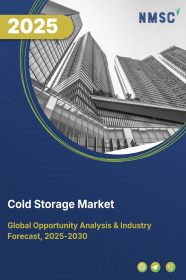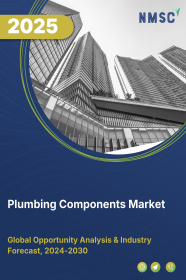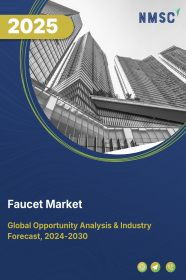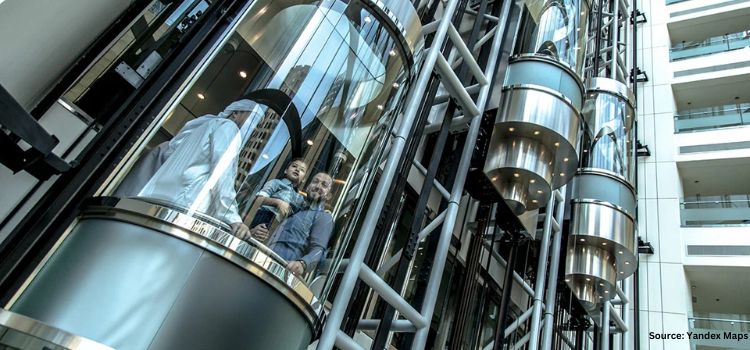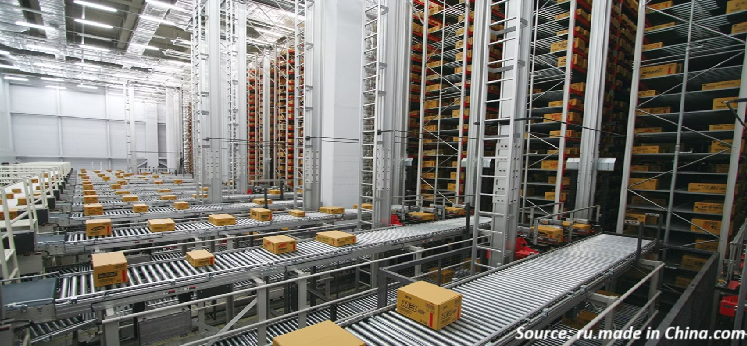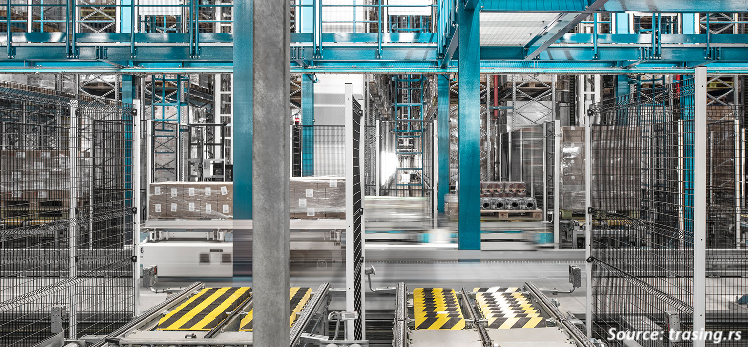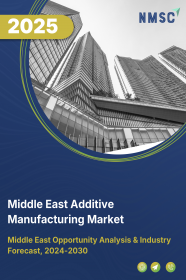
Middle East Additive Manufacturing Market by Type (Desktop 3D Printer and Industrial 3D Printer), by Technology (Stereolithography, Fused Deposition Modeling, Selective Laser Sintering, Direct Metal Laser Sintering, Polyjet Printing, Inkjet Printing, Electron Beam Melting, Laser Metal Deposition, Digital Light Processing, Laminated Object Manufacturing, and Other Technology), and Others – Opportunity Analysis and Industry Forecast, 2024–2030
Industry: Construction & Manufacturing | Publish Date: 14-Feb-2025 | No of Pages: 138 | No. of Tables: 102 | No. of Figures: 67 | Format: PDF | Report Code : CM675
US Tariff Impact on Middle East Additive Manufacturing Market
Trump Tariffs Are Reshaping Global Business
Middle East Additive Manufacturing Market Overview
Middle East Additive Manufacturing Market size was valued at USD 31.9 million in 2023, and is predicted to reach USD 74.5 million by 2030, at a CAGR of 11.4% from 2024 to 2030. In terms of volume, the market size was 10 thousand units in 2023, and is projected to reach 38 thousand units by 2030, with a CAGR of 19.6% from 2024 to 2030.
The additive manufacturing (AM) market, also referred to as additive layer manufacturing (ALM) or three-dimensional (3D) printing, is a global industry dedicated to developing, producing, and distributing technologies and materials used to fabricate three-dimensional objects layer by layer from digital models. This market serves diverse sectors, including aerospace, automotive, healthcare, and consumer goods, providing advanced solutions for prototyping, production, and customized manufacturing needs.
AM is highly valued for its capacity to produce intricate and personalized components while minimizing material waste, resulting in significant cost savings and environmental benefits. A distinguishing characteristic of this market is its wide array of printing technologies, such as stereolithography (SLA), selective laser sintering (SLS), and fused deposition modeling (FDM), each tailored to meet specific industry requirements and applications. Moreover, AM's capability for rapid prototyping accelerates product development cycles, empowering businesses to innovate and bring products to market more swiftly compared to traditional manufacturing methods.
Advancement of Construction Sector Accelerates the Growth of the Market
The advancement of the construction sector is driving the demand for additive manufacturing (AM) in the region as the industry pursues innovative solutions to enhance efficiency, reduce costs, and realize complex architectural designs. AM technologies enable rapid prototyping, customization of construction components, and on-site manufacturing, crucial for meeting ambitious infrastructure projects and smart city initiatives across the country. For example, in March 2024, Forsan Real Estate completed the world's first 3D-printed mosque in Jeddah, Saudi Arabia, a 5,600 square meter structure built in just six months using advanced 3D printing techniques. This highlights the increasing integration of AM in the construction sector, facilitating the creation of intricate, high-precision building elements to expedite project timelines and minimize material waste.
Rising Implementation of Government Initiatives Towards Development of 3D Printing Boosts the Market Growth
The adoption of government initiatives in the region is driving the Middle East additive manufacturing market demand for 3D printing by setting ambitious targets and providing robust support for innovation. For instance, under the Dubai 3D Printing Strategy launched in 2016, the UAE aims to become a global hub for 3D printing technology by 2030, focusing on key sectors such as construction, healthcare, and aerospace. Government efforts include offering incentives, fostering partnerships, and investing in research and development to create an environment conducive to the growth and integration of 3D printing technologies throughout the country. These initiatives position the UAE as a leader in advancing 3D printing applications across various industries, supporting economic diversification and technological advancement initiatives.
High Initial Investment Hinders the Market Growth
The significant initial investment needed for AM equipment, materials, and training represents a major barrier to Middle East additive manufacturing market trends. This financial commitment presents a significant challenge, especially for smaller businesses, restricting their ability to enter or scale within the market.
Moreover, ongoing costs associated with materials and training compound the financial burden. As a result, numerous businesses hesitate to adopt AM technology due to these financial hurdles, ultimately limiting prospects of the Middle East additive manufacturing market growth.
Integration of Artificial Intelligence (AI) in Additive Manufacturing Presents Lucrative Opportunity for Market Expansion
Integrating artificial intelligence (AI) into additive manufacturing (AM) is anticipated to expand the 3D printing market by refining production processes, enhancing product design capabilities, and facilitating the creation of intricate and personalized objects. AI integration enables businesses to analyze extensive datasets gathered during printing, such as material properties, printing parameters, and environmental conditions. This analysis helps identify patterns, optimize settings, and predict potential defects, thereby improving printing precision and reducing material waste.
Competitive Landscape
The prominent key players operating in Middle East additive manufacturing industry include D2M Solutions, Immensa Technology Labs, Team Visual Solutions, Printie 3D, Amtech 3D, IRIS 3D Solutions, KSA 3D, Sinterex, DuBox, Concreative, and others.
Middle East Additive Manufacturing Market Key Segments
By Type
-
Desktop 3D Printer
-
Industrial 3D Printer
By Technology
-
Stereolithography
-
Fused Deposition Modeling
-
Selective Laser Sintering
-
Direct Metal Laser Sintering
-
Polyjet Printing
-
Inkjet Printing
-
Electron Beam Melting
-
Laser Metal Deposition
-
Digital Light Processing
-
Laminated Object Manufacturing
-
Other Technology
By Component
-
Hardware
-
Software
-
Design Software
-
Inspection Software
-
Printer Software
-
Scanning Software
-
-
Services
By Application
-
Prototyping
-
Tooling
-
Functional Parts
By End User
-
Desktop Additive Manufacturing
-
Educational Purpose
-
Fashion & Jewellery
-
Objects
-
Dental
-
Food
-
Other Desktop Additive Manufacturing
-
-
Industrial Additive Manufacturing
-
Automotive
-
Aerospace & Defense
-
Healthcare
-
Consumer Electronics
-
Power & Energy
-
Other Industrial Additive Manufacturing
-
Key Players
-
D2M Solutions
-
Immensa Technology Labs
-
Team Visual Solutions
-
Printie 3D
-
Amtech 3D
-
IRIS 3D Solutions
-
KSA 3D
-
Sinterex
-
DuBox
-
Concreative
REPORT SCOPE AND SEGMENTATION:
|
Parameters |
Details |
|
Market Size Value in 2023 |
USD 31.9 million |
|
Revenue Forecast in 2030 |
USD 74.5 million |
|
Growth Rate |
CAGR 11.4% from 2024 to 2030 |
|
Market Volume in 2023 |
10 thousand units |
|
Market Forecast in 2030 |
38 thousand units |
|
Volume Growth Rate |
CAGR of 19.6% from 2024 to 2030 |
|
Analysis Period |
2023–2030 |
|
Base Year Considered |
2023 |
|
Forecast Period |
2024–2030 |
|
Market Size Estimation |
Million (USD) |
|
Growth Factors |
|
|
Companies Profiled |
10 |
|
Market Share |
Available for 10 companies |
|
Customization Scope |
Free customization (equivalent up to 80 working hours of analysts) after purchase. Addition or alteration to country, regional, and segment scope. |
|
Pricing and Purchase Options |
Avail customized purchase options to meet your exact research needs. |

















 Speak to Our Analyst
Speak to Our Analyst



